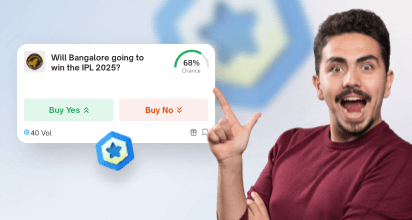Unlocking the Future: How Prediction Markets Are Revolutionizing Forecasting and Underwriting
How prediction markets power forecasting, audience insight, and underwriting—and how Vinfotech builds secure, enterprise-grade platforms.
A report on market-based forecasting, the voice of the crowd, and how Vinfotech builds enterprise-grade prediction market software
Executive overview
In a world where strategy cycles compress and uncertainty compounds, the ability to price the future is a competitive advantage. Prediction markets do exactly this. They allow people to trade contracts on future outcomes; the resulting prices behave like real-time probabilities. Unlike surveys or expert panels—which freeze sentiment at a moment in time—prediction markets update continuously as information arrives, giving leaders a living forecast they can act on.
At Vinfotech, we treat prediction market software not as a novelty game but as collective-intelligence infrastructure: a system that captures belief, quantifies conviction, and converts both into decisions across forecasting, underwriting, and product direction.
What a prediction market is—and why it works
Think of a stock exchange, but the “companies” are future events: “Product X hits 1M units in Q4,” “Team A keeps a clean sheet,” “CPI exceeds 4% next month.” If a ₹1.00 contract on “Product X hits 1M” trades at ₹0.64, the market implies a 64% probability of success. Prices move with news, research, and sentiment—producing a transparent, timestamped forecast curve.
Two properties make this powerful
1. Skin in the game: participants are rewarded for accuracy, not noise.
2. Continuity: prices adjust minute-by-minute; you see belief change, not just belief stated.
This is market-based forecasting in practice.
Models that listen to the user’s voice: F2P reach, P2P precision
Free-to-play (F2P) platforms remove friction and scale to large, diverse audiences. They are ideal for broadcasters, leagues, brands and publishers seeking to listen at scale—to capture the voice of the user and translate it into audience sentiment without payments or regulatory drag. Prizes can be points, perks, or sponsor rewards. The output is breadth: wide samples, rich demographic trend analysis, and high-frequency updates.
Pay-to-play (P2P) platforms—where permitted—attract smaller but more research-driven cohorts. Financial stakes sharpen incentives, often improving calibration and reducing noise. These deployments require KYC/AML, geo-controls, responsible gaming, and clear dispute resolution. The output is depth: higher-signal forecasts that many teams use for underwriting and risk decisions.
Many organizations operate both: F2P for mass-market pulse; P2P for high-signal cohorts. Used together, they create a panoramic view of belief.
From pulse to practice: applications across industries
Retail and consumer goods
Before a seasonal launch, a retailer opens markets on sell-through by week, regional uptake, and promotional lift. As the probability curves evolve, the merch team rebalances inventory, marketing trims discount depth where confidence is high, and underwriting sets caps for “sell-out guarantees.” The market becomes a rolling risk assessment rather than a single pre-launch bet.
Healthcare and pharmaceuticals
R&D leaders run internal markets on phase-transition success, regulatory timelines, and adoption likelihood for devices. Budget allocation follows the market’s confidence, surfacing weak candidates earlier and concentrating resources on higher-probability paths—while documenting how beliefs changed as trial data arrived.
Media and entertainment
Studios and streamers forecast opening weekend ranges, series completion rates, and pilot pickups using public or private markets. Marketing adapts creative to cohorts where the market shows conviction; programming teams time ad breaks and pushes by monitoring volatility and confidence (depth, spreads).
Technology and product development
Product teams trade on feature adoption, churn impact, and roadmap milestones. A stubbornly low probability on a “flagship” feature is a signal to interrogate assumptions, reroute design effort, or run controlled A/Bs. Internally, this is crowd forecasting software that surfaces risk weeks before status reports would.
Finance, macro, and events
Event-contract boards on inflation prints, rate decisions, or policy approvals operate as market-based indicators for CFOs and treasuries. Promotions tied to macro outcomes can be priced and capped using market odds, turning vague uncertainty into bounded exposure.
Underwriting with prediction markets
When forecasts are stable and well-calibrated, they inform pricing for guarantees, promotions, and event-linked offers. If a market puts a “clean-sheet” probability at 22%, a broadcaster can structure a sponsor offer around that likelihood, cap liability, and hedge if needed. The mechanics require three disciplines: clear resolution oracles, audit trails, and dispute workflows. Underwriting here is not gambling; it is transparent pricing of uncertainty.
The data layer: from sentiment to signal you can trust
A credible prediction market platform is as much a data product as it is a trading engine.
- Forecast curves: probabilities over time, annotated with news or moments that moved the price.
- Confidence indicators: order-book depth, spreads, and volatility to separate robust consensus from thin markets.
- Cohort views (consented): probabilities by age bands, regions, device types, or fan affinities to reveal how different groups “see” the future.
- Calibration metrics: Brier scores and reliability diagrams to verify that 60% outcomes really happen ~60% of the time.
Privacy is designed in: explicit opt-ins, cohorting rather than pinpoint PII, tokenized identifiers, and support for data-subject requests under GDPR/CCPA/DPDP-style regimes.
Designing for fairness, safety, and compliance
Forecast quality collapses without guardrails. Enterprise deployments include
- Market hygiene: position limits, circuit breakers, manipulation detection.
- Resolution clarity: pre-declared oracles, evidence logs, transparent appeals.
- Responsible participation: limits, cool-offs, self-exclusion for P2P.
- Compliance posture: jurisdictional feature flags, KYC/AML where required, and clean fee disclosures.
Trust is a product feature.
Implementation that starts from decisions, not features
Successful programs begin with the decisions you intend to make when the probability moves.
- Discovery: use cases, jurisdictions, market templates, consent model, and integrations (data feeds, CRM/CDP, loyalty).
- Pilot: a focused set of markets with a serious analytics console—forecast curves, cohort deltas, calibration.
- Scale: combinatorics and range markets, sponsor dashboards, formal governance for oracles and disputes.
This is how prediction markets graduate from “interesting” to operational.
Why Vinfotech
Vinfotech builds custom prediction market software for enterprises that need both engagement and accuracy. Our work spans iGaming prediction markets, internal crowd forecasting, and event contract platforms that support underwriting and risk-aware promotions.
What we bring
- Product depth: binary, multi-outcome, range, and combinatorial markets; order-book or AMM liquidity; odds APIs and real-time data exports.
- Analytics first: probability timelines, calibration panels, demographic trend analysis with consented cohorts, and sponsor-ready dashboards.
- Enterprise discipline: observability, replayable order flow, audit trails, SLOs/SLAs, rollbacks.
- Compliance and safety: KYC/AML hooks, geo-controls, responsible gaming, clear resolution oracles and disputes.
- Design and UX craft: fast predictors for F2P scale; powerful consoles for analysts, risk teams, and partners.
Whether you want to listen to the user’s voice at scale (F2P), surface sharper signals for underwriting (P2P), or run private enterprise markets for delivery risk, we’ll architect the platform to your decisions, your jurisdictions, and your brand.
Conclusion
Prediction markets transform uncertainty from a vague narrative into a measurable, time-stamped probability. Used well, they augment strategy, guide underwriting, and make product bets more honest. The beauty is not only in the mechanics, but in the depth of insight they produce—who believes, how strongly, and how that belief changes with evidence.
If you’re ready to turn audience pulse into a forecast you can act on, Vinfotech can help you design, build, and operate a prediction market platform that meets enterprise standards from day one.
About Vinfotech
Vinfotech creates world’s best fantasy sports-based entertainment, marketing and rewards platforms for fantasy sports startups, sports leagues, casinos and media companies. We promise initial set of real engaged users to put turbo in your fantasy platform growth. Our award winning software vFantasy™ allows us to build stellar rewards platform faster and better. Our customers include Zee Digital, Picklive and Arabian Gulf League.















